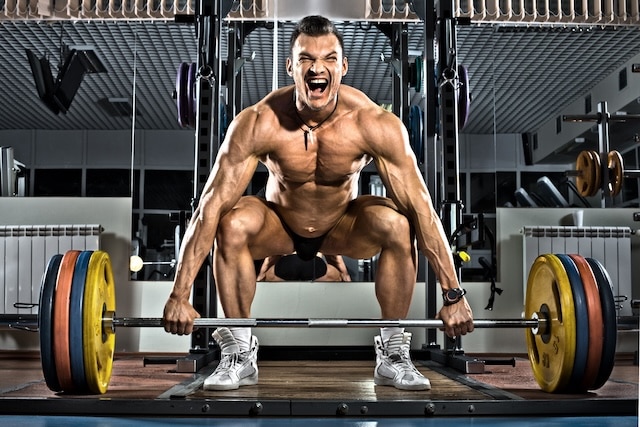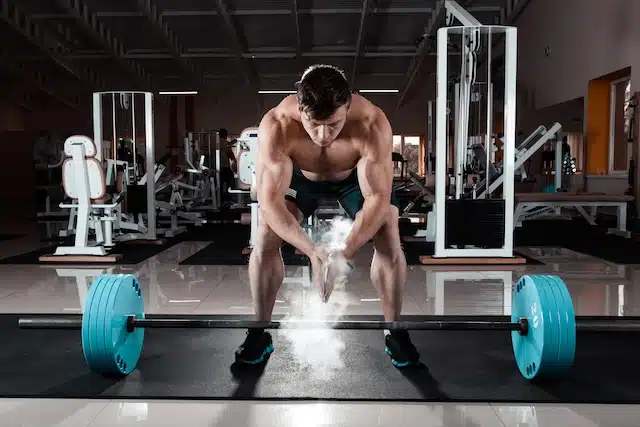Snatch Grip Deadlift: Benefits, How to Do, Muscles Worked
The Snatch Grip Deadlift is a powerful, often underutilized exercise that provides a unique way to improve strength, stability, and mobility. Unlike a conventional deadlift, the wider grip challenges the upper back, core, and lower body in ways that translate directly into athletic performance.
Athletes, especially those aiming to improve explosive power, will find this exercise highly beneficial.
During college, I often used the Snatch Grip Deadlift as part of my training routine to increase vertical jump height and improve lower-body power production.
The key, however, is to prioritize proper form and avoid rushing to heavier weights. It’s a tough but incredibly rewarding exercise that lays the foundation for excellent strength development and explosive movements.
For athletes and fitness enthusiasts, it’s a must-try for boosting performance in a well-rounded and functional way.
Benefits of the Snatch Grip Deadlift
The Snatch Grip Deadlift involves holding the barbell with a wider-than-shoulder-width grip, mimicking the grip used in Olympic weightlifting snatches.
This wider grip forces your body into a lower starting position, increasing the range of motion and engagement of key muscle groups.

This is truly a full-body powerhouse that offers unique benefits compared to traditional deadlifts:
Builds a Stronger, More Muscular Upper Back
The wide grip significantly increases the activation of the trapezius, rhomboids, rear delts, and lats, making it one of the best deadlift variations for upper-back development.
- The increased time under tension forces these muscles to work harder, improving back strength and endurance.
- By reinforcing scapular stability, it helps prevent rounded shoulders, reducing the risk of postural imbalances and injuries.
- A stronger upper back translates to better performance in squats, overhead presses, and Olympic lifts.
This makes the Snatch Grip Deadlift a staple for weightlifters, powerlifters, and athletes looking to enhance their upper-body resilience.
Improves Hip and Hamstring Mobility
Since the wide grip forces a lower starting position, your hamstrings, glutes, and hips experience a deeper stretch than in a conventional deadlift.
- Over time, this increased stretch helps improve hamstring flexibility, reducing stiffness and the risk of strains.
- The deeper hip position enhances hip mobility, which is crucial for athletes in sports that require powerful hip extension, such as sprinting, jumping, and cutting movements.
- This mobility benefit also translates to improved squatting depth and better performance in Olympic weightlifting.
By reinforcing better movement mechanics, this exercise is an excellent addition for lifters seeking greater flexibility and injury prevention.
Increases Core Stability and Bracing Strength
Maintaining proper posture with a wide grip requires significant core engagement, making this variation an outstanding tool for developing total-body stability.
- The extended range of motion forces the rectus abdominis, obliques, and deep core muscles to work harder to maintain a neutral spine.
- A stronger core reduces the likelihood of lower back rounding, a common issue in traditional deadlifts.
- This increased core activation carries over to other lifts, such as squats, cleans, and even overhead presses.
For athletes and lifters alike, a stronger core means improved performance and a reduced risk of lower back injuries.
Enhances Grip Strength and Endurance
The wide grip challenges finger, hand, wrist, and forearm strength far more than a conventional deadlift, making it an elite way to improve grip-strengthening.
- Because the hands are set wider, the mechanical advantage of the grip is reduced, forcing greater grip endurance.
- This improved grip strength translates to better performance in pull-ups, rows, Olympic lifts, and even combat sports where grip endurance is crucial.
- Athletes in wrestling, rock climbing, and football can benefit significantly from the increased forearm strength and hand control developed through Snatch Grip Deadlifts.
For those struggling with grip fatigue in deadlifts or other pulling exercises, adding Snatch Grip Deadlifts to a training program can rapidly improve grip endurance and overall pulling power.
Develops Explosive Power for Sports Performance
The Snatch Grip Deadlift isn’t just about strength—it’s an essential exercise for developing explosive power, making it a key movement for athletes in various sports.
- The wide grip closely mimics the setup of Olympic lifts, reinforcing the explosive hip drive required for cleans and snatches.
- By increasing the range of motion and engagement of the posterior chain, this variation enhances the force production of the glutes, hamstrings, and lower back—critical for sprinting, jumping, and rapid directional changes.
- Basketball players, football players, and Olympic weightlifters use Snatch Grip Deadlifts to improve vertical jump, acceleration, and overall power output.
For athletes aiming to run faster, jump higher, and generate more force in their movements, the Snatch Grip Deadlift is a game-changing addition to their strength and power training.
How to Do the Snatch Grip Deadlift
- Set Up the Barbell: Place the barbell on the floor, load it with your desired weight, and stand with your feet hip-width apart. Your toes should point slightly outward.
- Grip the Barbell: Use an overhand grip (both palms facing down) and grab the barbell wider than shoulder-width apart. Your hands should be positioned slightly outside your knees.
- Lower Your Hips: Bend your knees and lower your hips as you position yourself to lift the barbell. Your chest should be up, your back flat, and your shoulders slightly in front of the bar.
- Lift the Barbell: Push through your heels and extend your hips and knees simultaneously to lift the barbell off the ground. Keep the bar close to your body as you stand up, fully extending your hips at the top.
- Lower the Barbell: Reverse the movement by hinging at your hips first, lowering the barbell back to the floor with control while maintaining a neutral spine.
- Repeat: Perform the desired number of repetitions, focusing on form and control.
Safety and Form Tips
- Warm Up Thoroughly: Stretch your hamstrings, hips, and shoulders, and do lighter sets to prep your muscles.
- Maintain a Neutral Spine: Keep your back flat and core engaged to protect your lower back.
- Start with a Light Weight: Master the form before increasing the load due to the wider grip and deeper position.
- Proper Foot Position: Keep feet hip-width apart and toes slightly out to maintain balance and knee alignment.
- Focus on Hip Hinge: Push your hips back, engaging glutes and hamstrings, rather than turning the lift into a squat.
- Keep the Bar Close: Maintain a close bar path along your body to reduce lower back strain.
- Control the Lowering Phase: Lower the bar slowly to build strength and reinforce proper form.
- Protect Shoulders: Engage your upper back, and use a slightly narrower grip if needed to avoid shoulder strain.
- Avoid Overextension: Don’t lean back at the top—lock your hips in a neutral position.
- Use Chalk or Straps if Needed: To prevent grip fatigue, use chalk or lifting straps for heavy sets.
Who Should Do This Exercise?
The Snatch Grip Deadlift is ideal for athletes and fitness enthusiasts looking to enhance their strength, power, and mobility. Specific groups who will benefit include:
- Olympic Lifters: The wide grip is a foundational component of the snatch, making this exercise essential for Olympic weightlifters.
- Athletes: Those in sports requiring explosive power—such as basketball, football, and hockey—can use this exercise to improve performance.
- Strength Enthusiasts: Lifters looking to develop a stronger posterior chain, better grip strength, and better flexibility will find this exercise extremely beneficial.
- Rehabilitation Patients: If done with lighter loads, it can improve mobility and core stability for those recovering from lower back or hip injuries.
Muscles Worked
The Snatch Grip Deadlift is a comprehensive full-body exercise, but it emphasizes certain muscle groups more than others:
- Trapezius (Upper Back): The wider grip targets the traps more intensely, helping develop a stronger and more stable upper back.
- Rhomboids and Rear Deltoids (Shoulders and Upper Back): These muscles help stabilize the shoulder blades and provide extra support throughout the movement.
- Hamstrings and Glutes (Posterior Chain): The extended range of motion increases the involvement of the hamstrings and glutes, which are responsible for generating power during the lift.
- Core and Lower Back: Keeping a neutral spine during the movement demands a high level of core activation, improving core strength and stability.
- Forearms and Grip Muscles: The wide grip requires strong forearms and grip strength, which translates to better performance in other lifts and sports.
Read Next: Deadlifts vs Back Squats: Which are Better?



